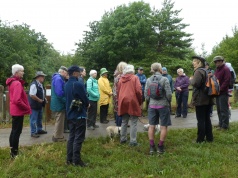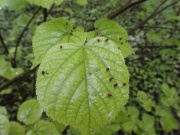As part of celebrations to mark the 30th Anniversary of the Magog Trust, Friends were invited to join a “Sunday Stroll on Magog Down” and discover more about its flowers, birds, and trees.
Around twenty people met on a cool, drizzly Sunday morning on Magog Down, only a couple or so days after the highest ever temperature in the country had been recorded in Cambridge. This did not dampen the interesting hour or so spent with Conservation Rangers, Claire and Nick Beale who took the group on a stroll around North Down where the many varied wild flowers and shrubs were identified.


Wild parsnip and hawkweed ox-tongue turned the Down yellow, with patches of purple from Wild Marjoram, Wild basil and clustered bell flower punctuated with clouds of wild carrot: lacy white with its tiny red dot in the centre. It resembled a meticulous prairie planting by Piet Oudolf. Other chalkland identifier species like bird’s foot trefoil, scabious and woolly thistle could be seen. Our resident kestrel flew above Youth Wood, whilst around a dozen swallow skimmed the top of the grasses of the meadow.
Claire showed examples of guelder rose and spindle, the latter not yet showing its brilliant pink fruits. She commented on other fruits which could be found on the Down such as sloes and blackberries. Nick pointed out the sharp barbs of agrimony seeds, often caught in dogs’ hair while walking. Clusters of bedstraw, flowers just turning over, grew beneath the taller species.
Looking over towards Stapleford village, Feoffee Fields, managed by The Trust, were swathed with brown streaks, seed heads from the ox-eye daisies. We paused near the top of Little Trees Hill, encircled by the Neolithic Causewayed Enclosure and topped by the Bronze Age Bowl Barrow, being managed back to turf. The rain meant that no butterflies could be seen, nor the view over the sheep paddocks to the south, though a tinge of blue Phacelia tanacetifolia could just be made out in the bird seed strip. Claire showed examples of mustard and millet also to be found in the strip.
The group paused by a small group of ash trees, decimated by ash die back. They would be left standing, a new habitat for insects and invertebrates. Finally, a point of interest on some leaves, galls formed after some mite had laid an egg in the leaf.
With rain falling steadily, it was agreed to return to the car park. The walk had certainly stirred an interest in all who attended.


